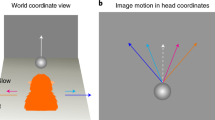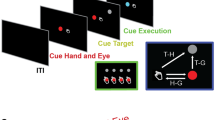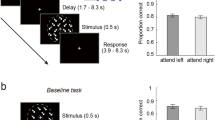Abstract
To look at or reach for what we see, spatial information from the visual system must be transformed into a motor plan. The posterior parietal cortex (PPC) is well placed to perform this function, because it lies between visual areas, which encode spatial information1,2, and motor cortical areas. The PPC contains several subdivisions, which are generally conceived as high-order sensory areas3,4. Neurons in area 7a and the lateral intraparietal area fire before and during visually guided saccades. Other neurons in areas 7a and 5 are active before and during visually guided arm movements5–10. These areas are also active during memory tasks in which the animal remembers the location of a target for hundreds of milliseconds before making an eye or arm movement. Such activity could reflect either visual attention11–15 or the intention to make movements16–22. This question is difficult to resolve, because even if the animal maintains fixation while directing attention to a peripheral location, the observed neuronal activity could reflect movements that are planned but not executed22. To address this, we recorded from the PPC while monkeys planned either reaches or saccades to a single remembered location. We now report that, for most neurons, activity before the movement depended on the type of movement being planned. We conclude that PPC contains signals related to what the animal intends to do.
This is a preview of subscription content, access via your institution
Access options
Subscribe to this journal
Receive 51 print issues and online access
$199.00 per year
only $3.90 per issue
Buy this article
- Purchase on SpringerLink
- Instant access to full article PDF
Prices may be subject to local taxes which are calculated during checkout
Similar content being viewed by others
References
Ungerleider, L. G. & Mishkin, M. in Analysis of Visual Behavior (eds Ingle, D. J., Goodale, M. G. & Mansfield, R. J. W.) 549–586 (MIT Press, Cambridge, MA, 1982).
Goodale, M. G. & Milner, A. D. Trends Neurosci. 15, 220–225 (1992).
Hyvärinen, J. & Poranen, A. Brain 97, 673–692 (1974).
Gross, C. G. Cereb. Cortex 5, 455–469 (1994).
Hartje, W. & Ettlinger, G. Cortex 9, 346–354 (1974).
Mountcastle, V. B., Lynch, J. C., Georgopoulos, A., Sakata, H. & Acuna, C. J. Neurophysiol. 38, 871–908 (1975).
Seal, J. & Commenges D. Exp. Brain Res. 58, 144–153 (1985).
Shibutani, H., Sakata, H. & Hyvarinen, J. Exp. Brain Res. 55, 1–88 (1984).
Andersen, R. A., Essick, G. K. & Siegel, R. M. Exp. Brain Res. 67, 316–322 (1987).
Murata, A., Gallese, V., Kaseda, M. & Sakata, H. J. Neurophysiol. 75, 2180–2186 (1996).
Robinson, D. L., Goldberg, M. E. & Stanton, G. B. J. Neurophysiol. 41, 910–932 (1978).
Bushnell, M. C., Goldberg, M. E. & Robinson, D. L. J. Neurophysiol. 46, 755–772 (1981).
Duhamel, J.-R., Colby, C. & Goldberg, M. E. Science 255, 90–92 (1992).
Steinmetz, M. A., Conner, C. E., Constantinidis, C. & McLaughlin, J. R. J. Neurophysiol. 72, 1020–1023 (1994).
Colby, C. L., Duhamel, J. R. & Goldberg, M. E. Cereb. Cortex 5, 470–481 (1995).
Gnadt, J. W. & Andersen, R. A. Exp. Brain Res. 70, 216–220 (1987).
Andersen, R. A. Annu. Rev. Neurosci. 12, 377–403 (1989).
Thier, P. & Andersen, R. A. Proc. Natl Acad. Sci. USA 93, 4962–4967 (1996).
Shadlen, M. N. & Newsome, W. T. Proc. Natl Acad. Sci. USA 93, 628–633 (1996).
Mazzoni, P., Bracewell, R. W., Barash, S. & Andersen, R. A. J. Neurophysiol. 76, 1439–1456 (1996).
Andersen, R. A. Cereb. Cortex 5, 457–469 (1995).
Bracewell, R. W., Mazzoni, P., Barash, S. & Andersen, R. A. J. Neurophysiol 76, 1457–1464 (1996).
Goldberg, M. E. & Bushnell, M. C. J. Neurophysiol. 46, 773–787 (1981).
Kalaska, J. F. & Crammond, D. J. Cereb. Cortex 5, 410–428 (1995).
Lynch, J. C., Mountcastle, V. B., Talbot, W. H. & Yin, T. C. T. J. Neurophysiol. 40, 362–389 (1977).
Bon, L. & Lucchetti, C. Exp. Brain Res. 102, 259–271 (1994).
Scott, D. W. Ann. Statist. 13, 1024–1040 (1985).
Author information
Authors and Affiliations
Rights and permissions
About this article
Cite this article
Snyder, L., Batista , A. & Andersen, R. Coding of intention in the posterior parietal cortex. Nature 386, 167–170 (1997). https://doi.org/10.1038/386167a0
Received:
Accepted:
Issue Date:
DOI: https://doi.org/10.1038/386167a0
This article is cited by
-
Decision-making processes in perceptual learning depend on effectors
Scientific Reports (2024)
-
Position- and scale-invariant object-centered spatial localization in monkey frontoparietal cortex dynamically adapts to cognitive demand
Nature Communications (2024)
-
Neurons as will and representation
Nature Reviews Neuroscience (2022)
-
Dual-stream encoder neural networks with spectral constraint for clustering functional brain connectivity data
Neural Computing and Applications (2022)
-
Comparative metabolic profiling of posterior parietal cortex, amygdala, and hippocampus in conditioned fear memory
Molecular Brain (2021)



